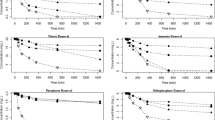Abstract
In the present study, microcalorimetry was used to monitor the non-growth metabolism of Nitrosomonas europaea (N. europaea) cells, which could biodegrade the micropollutant (triclosan). The presence of triclosan promote non-growth metabolism and extend the life of N. europaea cells. However, at high concentration of triclosan (4 mg L−1), the acute toxicity was induced in cells. The addition of allylthiourea inhibited the non-growth metabolism of N. europaea, suggesting that ammonia monooxygenase is responsible for the biodegradation of triclosan. Scanning electron microscopy result showed the cell membrane damage induced by triclosan. It is concluded that triclosan would bind to ammonia monooxygenase on the cell membrane and cause acute toxicity. Triclosan (<1.0 mg L−1) is favor for the non-growth metabolism, while high concentration (4.0 mg L−1) is toxic to N. europaea cells.




Similar content being viewed by others
References
Li Z, Claude EB. Total ammonia nitrogen removal from aqueous solutions by the natural zeolite, mordenite: a laboratory test and experimental study. Aquaculture. 2014;432:252–7.
Qianwen S, Chong L, Hongmin D, Zhiping Z. Effect of ammonium nitrogen concentration on the ammonia-oxidizing bacteria community in a membrane bioreactor for the treatment of anaerobically digested swine wastewater. J Biosci Bioeng. 2014;118:277–83.
Hanxin H, Hai L, Yingbo D, Huang C, Han W, Lixia C. Ammonia-nitrogen and phosphates sorption from simulated reclaimed waters by modified clinoptilolite. J Hazard Mater. 2012;229:292–7.
Young MK. Acclimatization of communities of ammonia oxidizing bacteria to seasonal changes in optimal conditions in a coke wastewater treatment plant. Bioresour Technol. 2013;147:627–31.
Xiaohui W, Xianghua W, Craig C, George W, Jie Z, Yin Z. Community analysis of ammonia-oxidizing bacteria in activated sludge of eight wastewater treatment systems. J Environ Sci. 2010;22:627–34.
Nicholas JW, Jan S. Osmotic stimulation of microcolony development by Nitrosomonas europaea. FEMS Microbiol Ecol. 1998;28:175–83.
Saskia G, Henk D, Hendrikus JL. Ammonium-induced inhibition of ammonium-starved Nitrosomonas europaea cells in soil and sand slurries. FEMS Microbiol Ecol. 1998;26:269–80.
Zhao F. Biodegradation of triclosan by an ammonia-oxidizing bacterium Nitrosomonas europaea and a triclosan-degrading bacterium. KCY1. Zachry, Department of Civil Engineering, Texas A&M University, College Station, Texas. 2006.
Ghada B, Mohammed MA. Studying the physico–chemical properties of commercially available oil-well cement additives using calorimetry. J Therm Anal Calorim. 2013;111:295–303.
Xuesong S, Meihua J, Chunxia Z, Xinqiang T, Hanfu L, Xuelian Q. Microcalorimetric study of the effect of artesunate on the growth metabolism of mitochondria isolated from rat liver. J Therm Anal Calorim. 2013;111:1947–52.
Peng L, Yi L, Jia H, Fengjiao D, Daiwen P, Songsheng Q. J Therm Anal Calorim. 2003;73:843–9.
Singer H, Mueller S, Tixier C, Pillonel L. Triclosan: occurrence and fate of a widely used biocide in the aquatic environment: field measurements in wastewater treatment plants, surface waters, and lake sediments. Environ Sci Technol. 2002;36:4998–5004.
Rasche ME, Hyman MR, Arp DJ. Factors limiting aliphatic chlorocarbon degradation by Nitrosomonas europaea: cometabolic inactivation of ammonia monooxygenase and substrate specificity. Appl Environ Microbiol. 1991;57:2986–94.
Mark S, Kim HS. Evaluating the performance of activated sludge ammonia oxidizing bacteria in a lab-scale alternating hypoxic/oxic membrane bioreactor. Chem Eng J. 2014;255:670–6.
James WB, Moir LC, Crossman SS, David JR. The purification of ammonia monooxygenase from Paracoccus denitrficans. FEBS Lett. 1996;387:71–4.
Acknowledgements
We gratefully acknowledge the financial support of Major Special Technological Programmes Concerning Water Pollution Control and Management (Granted No. 2012ZX07201002-3) and Open Project of State Key Laboratory of Urban Water Resource and Environment, Harbin Institute of Technology (No. QA201206).
Author information
Authors and Affiliations
Corresponding author
Rights and permissions
About this article
Cite this article
Qiu, S., Ma, F., Huang, X. et al. Microcalorimetric study on biodegradation kinetic of micropollutant in wastewater by ammonia-oxidizing bacteria. J Therm Anal Calorim 120, 345–349 (2015). https://doi.org/10.1007/s10973-014-4261-x
Received:
Accepted:
Published:
Issue Date:
DOI: https://doi.org/10.1007/s10973-014-4261-x




